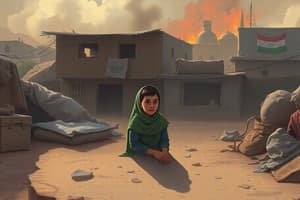Podcast
Questions and Answers
What is the primary aim of the research conducted as part of the British Council's EDGE programme?
What is the primary aim of the research conducted as part of the British Council's EDGE programme?
- To investigate the political implications of education during conflicts
- To analyze the financial impact of the conflict on education systems
- To assess challenges and opportunities for adolescents in accessing education and digital resources (correct)
- To evaluate the effectiveness of ICT tools used in educational settings
Which methodology involves direct engagement with communities to collect data?
Which methodology involves direct engagement with communities to collect data?
- Archive analysis
- Participatory Research (correct)
- Surveys
- Case studies
What aspect of research implementation is crucial for maintaining data integrity?
What aspect of research implementation is crucial for maintaining data integrity?
- Community engagement
- Continuous feedback
- Quality control (correct)
- Remote sensing
Which analysis type focuses on summarizing data characteristics?
Which analysis type focuses on summarizing data characteristics?
How does triangulation in research methodology enhance validity?
How does triangulation in research methodology enhance validity?
What role does the peer review process play in research analysis?
What role does the peer review process play in research analysis?
What is a potential outcome of engaging with warring actors in research?
What is a potential outcome of engaging with warring actors in research?
Which method is categorized under quantitative methodologies?
Which method is categorized under quantitative methodologies?
What type of research is aimed at understanding cultural practices and experiences?
What type of research is aimed at understanding cultural practices and experiences?
What significant factor influences adolescents' learning performance in the research context?
What significant factor influences adolescents' learning performance in the research context?
What is the minimum number of battle-related deaths required to classify an armed conflict according to UCDP?
What is the minimum number of battle-related deaths required to classify an armed conflict according to UCDP?
Which of the following is NOT considered a conflict according to the UCDP definition?
Which of the following is NOT considered a conflict according to the UCDP definition?
What distinguishes theories from frameworks in conflict research?
What distinguishes theories from frameworks in conflict research?
What constitutes a non-state conflict as per the UCDP's definition?
What constitutes a non-state conflict as per the UCDP's definition?
In the context of conflict, what are 'roots of the conflict' generally referring to?
In the context of conflict, what are 'roots of the conflict' generally referring to?
Which of the following factors is NOT included in the conflict context?
Which of the following factors is NOT included in the conflict context?
Which framework emphasizes the systematic organization of concepts in conflict research?
Which framework emphasizes the systematic organization of concepts in conflict research?
What role do dominant narratives play in the understanding of conflicts?
What role do dominant narratives play in the understanding of conflicts?
What is a characteristic of critical theory in the context of conflict research?
What is a characteristic of critical theory in the context of conflict research?
Which theory focuses on the psychological impact of conflicts on individuals?
Which theory focuses on the psychological impact of conflicts on individuals?
Flashcards
Armed Conflict Definition
Armed Conflict Definition
According to the Uppsala Conflict Data Program (UCDP), an armed conflict occurs when two opposing parties, at least one being a state government, engage in armed force, resulting in at least 25 battle-related deaths within a year.
Non-state Conflict Definition
Non-state Conflict Definition
A non-state conflict occurs when two organized armed groups, neither of which is a state government, engage in armed force, resulting in at least 25 battle-related deaths within a year.
Difference between Frameworks and Theories
Difference between Frameworks and Theories
Frameworks offer structured thinking models that organize core concepts and connections without providing causal explanations, while theories provide specific, tested explanations for phenomena.
Critical Theory
Critical Theory
Signup and view all the flashcards
Marxist Theory
Marxist Theory
Signup and view all the flashcards
Feminist Theory
Feminist Theory
Signup and view all the flashcards
Post-Colonial Theory
Post-Colonial Theory
Signup and view all the flashcards
Structural Violence Theory
Structural Violence Theory
Signup and view all the flashcards
Trauma Theory
Trauma Theory
Signup and view all the flashcards
Human Security Theory
Human Security Theory
Signup and view all the flashcards
Ethnography
Ethnography
Signup and view all the flashcards
Participatory research
Participatory research
Signup and view all the flashcards
Surveys
Surveys
Signup and view all the flashcards
Discourse analysis
Discourse analysis
Signup and view all the flashcards
Archive analysis
Archive analysis
Signup and view all the flashcards
Case studies
Case studies
Signup and view all the flashcards
Remote sensing
Remote sensing
Signup and view all the flashcards
Triangulation
Triangulation
Signup and view all the flashcards
Research implementation
Research implementation
Signup and view all the flashcards
System analysis
System analysis
Signup and view all the flashcards
Study Notes
Definitions of Armed Conflict
- An armed conflict is defined as a contested incompatibility concerning government or territory, where armed force is used between two parties resulting in at least 25 battle-related deaths in a calendar year. At least one party must be the government of a state.
- A non-state conflict involves two organised armed groups, neither of which is a government, resulting in at least 25 battle-related deaths in a year.
Research in Conflict Areas: Syrian Case
- Research examines the Syrian conflict, encompassing diverse actors, contexts, and motivations.
Conflict Context in Syria
- The conflict started with social movements in 2011.
- This escalated into severe conflict, causing widespread human rights violations and deprivation.
- Various factors, including breakdowns in international and national mechanisms, resulted in large-scale losses and violence.
Methodology
-
The research employs a mixed-method approach combining qualitative and quantitative methods, including interviews, observations, focus groups and quantitative analysis.
-
Employing a variety of data collection methods allows better understanding, analysis and broader insight from the perspective of multiple actors.
-
The research uses a critical political economy framework to understand the conflict.
-
The methodology used is gender and age sensitive.
-
The research has assessed adolescent rights and analyzed gender inequalities and abuses.
-
Key tools include discussions with adolescents and key informant interviews.
Challenges
- The research acknowledges challenges like security concerns, fear of retaliation, COVID-19, difficulties in transportation for adolescents, and subjective biases.
- Challenges with access, challenges with data collection procedures and analysis.
Analysis Strategies
- Data analysis includes, but is not limited to, comparative studies, analyses of policy options, and pressure on warring factions.
Results
- The research aims to inform policy decisions, improve understanding, and contribute to more effective solutions for the conflict in Syria.
- Dialogue and feedback are integral to the research process using social media platforms.
Objectives, Motivations, and Positions
- Objectives: Understanding conflict dynamics, power shifts, environmental impacts on people and institutions, identifying alternative solutions, and influencing policymakers are key.
- Motivations: Contributing to knowledge production, personal career advancement, ethical considerations, influencing policies, addressing severe violations are key motivators.
- Positions: Activist, academic researcher, research participant, observer are positions involved or observed by the team.
Case Study: Voices of Adolescents on Education and ICT
- This case study investigates the challenges and opportunities facing adolescent girls and boys in Syria's education and information/communication technology.
- It seeks to understand their needs and aspirations, particularly in the context of the conflict.
- This research helps to develop policies that support adolescents.
Studying That Suits You
Use AI to generate personalized quizzes and flashcards to suit your learning preferences.




